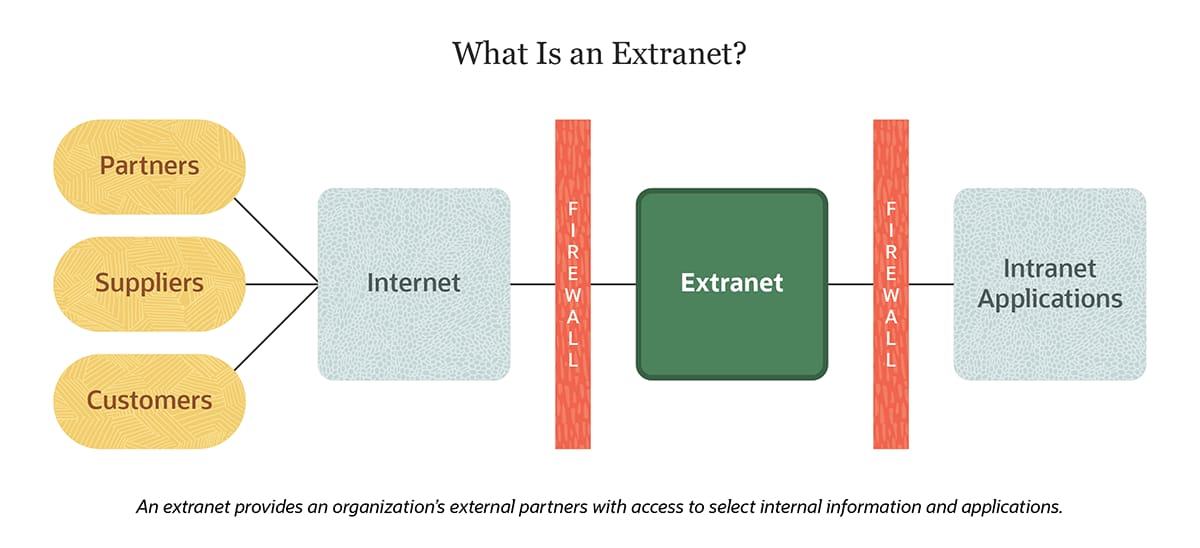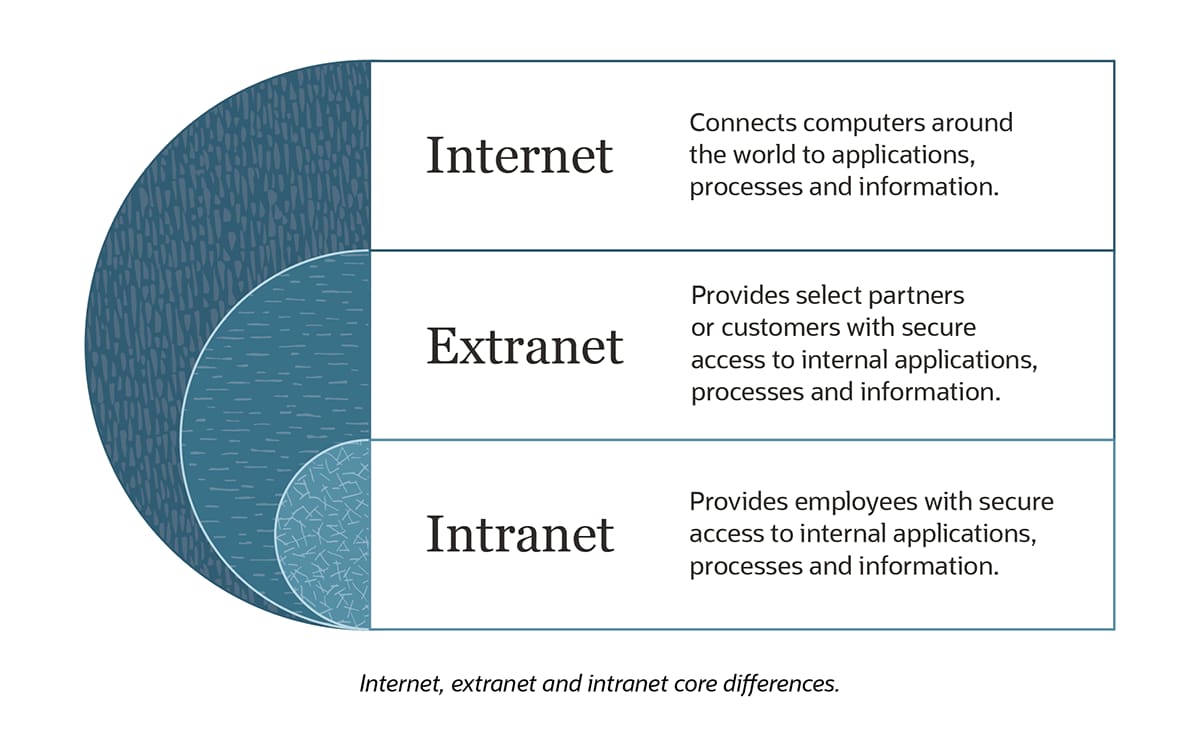Long before software-as-a-service and cloud computing emerged, organizations used extranets to provide external partners and other trusted third parties with secure and controlled access to their internal applications, information and processes. In today’s digital age of expanded corporate ecosystems, these private networks continue to serve as an important vehicle for knowledge-sharing and collaboration with suppliers, vendors and customers.
What Is an Extranet?
An extranet is a controlled private network, defined by Gartner as “a collaborative, internet-based network that facilitates intercompany relationships by linking an enterprise with its suppliers, customers or other external business partners.” Employing internet-derived applications and technology, organizations create extranets to securely extend their internal business data and processes to partners outside their four walls.
From a networking perspective, an IT team creates an extranet when they take an application built for internal users, often on their intranet, and extend it to select business partners or customers. The extranet can be used only by individuals who are granted secure access credentials.

Key Takeaways
- Extranets provide an organization’s partners and customers with controlled access to information or applications otherwise available only to internal employees.
- Like intranets, extranets can foster improved engagement and efficiency.
- Modern extranets offer robust capabilities, such as multiple communication options, project management tools, document storage and application integration.
- Organizations must consider cost, security and training before investing in an extranet.
Extranets Explained
At its most basic level, an extranet is a website or platform that gives trusted third parties, such as an organization’s vendors, suppliers and clients, access to information or applications typically reserved for employees on the organization’s own network. In some cases, the extranet exists as a secure extension of an organization’s internal network.
The term “extranet” first appeared in the late 1990s as organizations sought to take advantage of internet technologies to foster collaboration and knowledge-sharing with external parties. While extranets are less commonly used today, companies that need them can take advantage of modern internet capabilities and impose tight control via advanced access management technologies.
Extranet vs. Intranet: What’s the Difference?
Intranets and extranets are two sides of the same internet-powered coin. Both serve an important purpose: Enable greater productivity, collaboration and knowledge-sharing for key decision-makers. In the same way intranets foster employee engagement and communication, extranets engage stakeholders outside of the organization.
An intranet is a private network created by an organization to provide its own employees with access to internal applications, information and services. An extranet is essentially an intranet that organizations create for select partners or customers, granting access to specific applications, information and services. Although intranets and extranets both rely on internet technologies, they are sequestered from the public internet by firewalls and access controls.
| INTRANET | EXTRANET |
|---|---|
| Controlled private network that provides secure application and information access to employees only | Controlled private network that provides secure application and information access to third parties, such as suppliers or customers |
| Used for business intelligence, knowledge-sharing, content management, employee collaboration and document management | Used for partner collaboration and knowledge-sharing, custom development, corporate social media and partner or customer websites and portals |
| Owned by a single organization | May be owned by a single organization or multiple organizations |
| Regulated by single organization | May be regulated by contractual agreements between organizations or organizations and individuals |

Why Are Extranets Important to Businesses?
Although collaborative platforms have emerged that enable dispersed teams to communicate and collaborate remotely in real time, they are not well suited for more complex projects and tasks, such as supply-chain coordination, financial transactions, project management and customer interactions. Extranets let businesses take data and digital services, typically only available on their internal networks, and share them with important third parties. Extranets offer organizations a way to invite those outside of the company into their information systems to conduct business.
Today’s extranet platforms are far more capable and versatile than the extranets of yore, offering multiple communication options, project management tools, document storage and application integrations. In cases where businesses must collaborate with partners and customers to succeed, they are often a necessity.
How Are Extranets Used?
Extranets enable the wider distribution of and access to information and transactional capabilities more efficiently and securely than, for example, email or even a real-time collaboration network. They are particularly effective in cases where an organization needs to share large volumes of data, or data that is subject to compliance or security scrutiny. For example, accounting firms may use extranets to access important facts and figures from their clients during tax season, and manufacturers may use extranets to exchange information with suppliers.
The first extranets were repurposed intranets shared between two organizations. In some cases, they still are. However, the use of extranets has matured to support the creation of partner portals, collaborative team workspaces and customer websites.
Types of Extranets
Because modern extranets can deliver a range of capabilities — sharing large files, enabling real-time conversations and syncing calendars and timelines, for example — these digital, interactive platforms can take a number of forms. They continue to be widely used in the manufacturing settings in which they first emerged, enabling suppliers, distributors, logistics partners, product development teams and others to work more seamlessly in creating, building, selling and transporting goods.
But there is a wide variety of uses for extranets that span organizational functions:
- Project extranets can be used to centralize and coordinate project management tasks, providing a common workspace with access to shared documents and applications. Architects and builders, for example, use project extranets to better manage schedules, materials and other details.
- Integration extranets allow companies to integrate internal enterprise software and applications into a single extranet platform, often in real time, for collaboration among multiple parties. The automotive industry, for one, has a number of integration extranets connecting organizations in the car manufacturing ecosystem.
- Logistics extranets are collaborative platforms that let organizations manage logistics processes across multiple stages. They may incorporate manufacturing spreadsheets, vendor catalogs and financial reconciliation capabilities. Retailers, shippers and customers often use a single logistics extranet to track a product from sale to delivery.
- Financial extranets allow companies to exchange confidential financial data and perform transactions securely and quickly. For example, accounting firms may use a financial extranet to access important facts and figures from their clients during tax season.
- Customer extranets often take the form of platforms or portals that enable customers to perform some self-service functions, or report and share information in a more automated fashion. A client portal, for example, lets attorneys and law firms securely share information online with their clients.
- Employee information extranets can be used to disseminate important information and tools like timesheets or employee suggestions. These extranets are especially useful for organizations with large, dispersed front staff who don’t have network access, such as restaurants or hospitality, or in the case of franchises.
Extranet Advantages and Disadvantages
Extranets can offer significant benefits for companies, their employees, partners and customers. These secure connections can cut costs; improve efficiency; and bolster relationships and engagement with and among customers, partners and even internal employees. However, there are drawbacks and limitations to consider. In some scenarios, for example, an extranet may be an overly expensive solution for an organization’s requirements.
Advantages:
Among an extranet’s advantages:
- Improved engagement and communication: Extranets can be a common platform for company updates, announcements and information to boost engagement both internally and among partners.
- Increased productivity: By bringing together key information and capabilities in a centralized location, extranets can enhance organizations’ efficiency when collaborating with external partners or working with customers, particularly with complex tasks, projects and workflows.
- Streamlined collaboration and knowledge-sharing: An extranet can enable seamless document- and data-sharing, real-time updates and collaboration with parties outside the organization.
- Better security: When organizations invest in appropriate data protection, security and access controls, extranets provide a much more controlled environment for collaboration than email.
- Process integration and simplification: An extranet can help organizations consolidate processes, such as online sales, order tracking and inventory management, and simplify interfaces for partners or customers.
- Improved partner or customer relations: By fostering a more collaborative and integrated environment, extranets can improve customer and partner experiences and create closer relationships with key stakeholders.
- Greater flexibility: Extranets allow remote and mobile partners and customers to access core business information and applications anytime and anywhere.
Disadvantages:
Among an extranet’s disadvantages:
- Cost: In the age of cloud computing, some leaders may balk at the steep capital investment required to create and maintain extranets internally.
- Security requirements: While an extranet is a more controlled and protected environment for working with third parties than, say, email, any network access provided to outsiders carries risk. Organizations must invest in robust security to protect proprietary or confidential data as well as train staff to keep information safe.
- Training and change management: The company providing the extranet will need to offer training and onboarding for new users.
- Fewer face-to-face interactions: Extranets may reduce that “personal touch” that results when customers and business partners meet in person.
Examples of Extranets in the Enterprise
Today, organizations of all sizes, across industries and geographies, find value in incorporating extranets into their IT toolsets. Some extranets you may already be using are those supplied by logistics providers, such as FedEx or UPS, that allow shipping customers to access tracking updates in real time. Here’s a look at how other industries are putting extranets to work:
- Banks and financial services firms employ extranets to enable their customers to perform transactions.
- Government agencies, like the U.S. Internal Revenue Service, use extranets to enable citizens or businesses to submit documents online.
- Suppliers use extranets to make catalogs and ordering systems available to vendors.
- Design firms and architects employ extranets to give clients access to ongoing design and development.
- Educational institutions have rapidly adopted extranet technology to enable online learning and administration.
5 Tips for Creating an Extranet
If your organization has decided to build or buy an extranet to collaborate with partners or customers, there are best practices to keep in mind to ensure the system is both usable and secure.
-
Begin with business outcomes in mind. An extranet can open the door to a variety of functions and processes. It’s important to pinpoint the goals of the extranet before investing in any technology.
-
Decide what tasks and functionality to enable. Once the end goals are clear, determine what tasks and functionality you want to (and can) provide to the extranet’s users, and align choices with those in mind. This will guide your choices with regard to tools, design and more.
-
Invest in security from the start. Robust security is critical when inviting third parties to access your internal data and systems. Involve your security team from the beginning to ensure data safety considerations are baked into the design.
-
Consider user experience. Today’s extranets can be much more than a means of information exchange; users expect a good digital experience. That means investing in tools and capabilities that enhance the partner or customer experience.
-
Plan ahead for mobility. Most users now expect to be able to access key tasks on the go, so make sure to include the mobile experience in the design.
For organizations across a range of industries, extranets have evolved into a must-have tool for knowledge-sharing and collaboration among their most important stakeholders. Investing in a secure, user-friendly and functional extranet can pay off not only in increased efficiencies, but also in better relationships with partners, suppliers and customers.
#1 Cloud ERP
Software
Extranet FAQs
What does extranet mean?
At its most basic level, an extranet is an internet-based platform that gives third parties outside of an organization access to information or applications typically available only to internal users on the organization’s own network.
What is the purpose of an extranet?
An extranet is a controlled private network with internet connectivity that “facilitates intercompany relationships by linking an enterprise with its suppliers, customers or other external business partners,” as defined by Gartner. Employing internet-derived applications and technology, organizations create extranets to securely extend their internal business processes to trusted partners.
How are extranets used?
Extranets can be used in a variety of ways to collaborate with third parties, such as suppliers, vendors, customers and distributors. Modern extranets offer robust capabilities, including multiple communication options, project management tools, document storage and application integration. Some common type- include financial extranets, project management portals, logistics extranets, employee information hubs and customer portals.
What industries use extranets?
Manufacturers were some of the first enterprises to develop extranet solutions to collaborate and plan more effectively with their supply-chain partners. Today, a wide variety of organizations, of all sizes and across industries, employ extranets, including financial services, transportation and logistics, hospitality and restaurants, government and public sector, consulting, technology and retail.
What is an extranet with example?
An extranet provides an organization’s external partners with access to select internal information and applications. They are particularly effective in cases where an organization needs to share large volumes of data. For example, accounting firms may use extranets to access important facts and figures from their clients during tax season, and manufacturers may use extranets to exchange information with suppliers.
How do you create an optimized extranet solution?
In order to deliver an effective and secure extranet, an organization must first target the business outcomes it seeks. Only then can leaders select the best tools, functionality and security to provide the desired user experience.
What is the difference between an intranet and extranet?
An intranet is a private network created by an organization to provide its own employees with access to internal applications, information and services. An extranet is essentially an intranet that organizations create for select partners or customers, granting access to specific applications, information and services. Although intranets and extranets both rely on internet technologies, they are sequestered from the public internet by firewalls and access controls.









